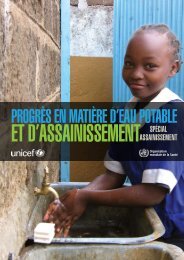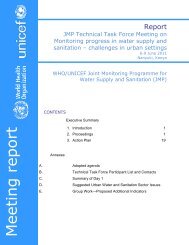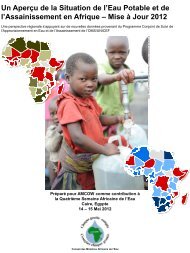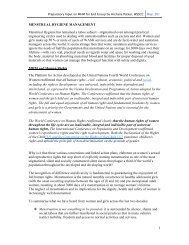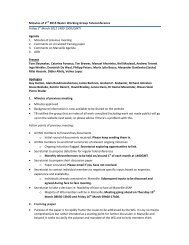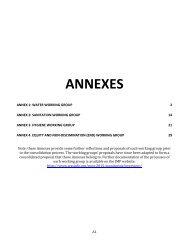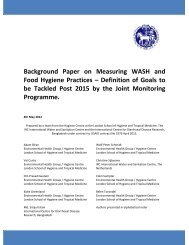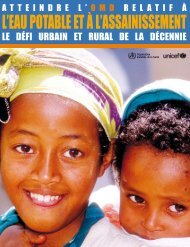rapid assessment of drinking-water quality in the republic of tajikistan
rapid assessment of drinking-water quality in the republic of tajikistan
rapid assessment of drinking-water quality in the republic of tajikistan
You also want an ePaper? Increase the reach of your titles
YUMPU automatically turns print PDFs into web optimized ePapers that Google loves.
Faecal contam<strong>in</strong>ation (<strong>the</strong>rmotolerant coliforms) and turbidity;<br />
Thermotolerant coliforms and faecal streptococci;<br />
Conductivity, and nitrate, fluoride and arsenic.<br />
Pearson’s r was used to measure <strong>the</strong> strength <strong>of</strong> association. This correlation coefficient measures <strong>the</strong><br />
l<strong>in</strong>ear association between two variables. If <strong>the</strong> data lie exactly along a straight l<strong>in</strong>e with positive<br />
slope, <strong>the</strong>n r = 1; if <strong>the</strong>y lie exactly along a straight l<strong>in</strong>e with negative slope, <strong>the</strong>n r = -1; if <strong>the</strong>re is no<br />
correlation, <strong>the</strong>n r = 0. The ma<strong>in</strong> limitations <strong>of</strong> Pearson’s r are that it measures only a l<strong>in</strong>ear<br />
association between two variables; it assumes a normal data distribution; and it is not resistant to<br />
outliers. The justifications for us<strong>in</strong>g it are that r can be easily calculated <strong>in</strong> Micros<strong>of</strong>t Excel, and that<br />
<strong>the</strong> RADWQ snapshot nature does not justify us<strong>in</strong>g a more complicated analysis.<br />
The only significant correlation was between <strong>the</strong>rmotolerant coliforms and faecal streptococci (r =<br />
0.52). For <strong>the</strong> o<strong>the</strong>r pairs <strong>of</strong> variables <strong>the</strong> correlations were negligible (Table 3.16).<br />
Table 3.16 Analysis <strong>of</strong> proxy parameters a<br />
Technology<br />
Pearson's r<br />
TTC vs.<br />
Conductivity vs.<br />
Turbidity FS NO 3 F As<br />
Utility piped supplies -0.05 0.42 0.07 0.01 N.A.<br />
Protected spr<strong>in</strong>gs 0.13 0.99 0.06 0.02 N.A.<br />
a<br />
Totals 0.00 0.52 0.08 0.02 N.A.<br />
FS = faecal streptococci. N.A. = data not available. TTC = <strong>the</strong>rmotolerant coliforms.<br />
3.8 Household <strong>water</strong> <strong>quality</strong><br />
The RADWQ survey also tested <strong>the</strong> <strong>quality</strong> <strong>of</strong> <strong>water</strong> consumed <strong>in</strong> households, to assess <strong>the</strong> extent to<br />
which <strong>water</strong> was contam<strong>in</strong>ated after leav<strong>in</strong>g <strong>the</strong> source. Household <strong>water</strong> was matched to a source,<br />
which meant that this part <strong>of</strong> <strong>the</strong> RADWQ survey only tested <strong>water</strong> from households with a known<br />
<strong>water</strong> supply. As a result, 10% <strong>of</strong> <strong>the</strong> total sample size <strong>of</strong> 1600 (i.e. 160 households) were <strong>in</strong>cluded <strong>in</strong><br />
<strong>the</strong> survey, with <strong>the</strong> households be<strong>in</strong>g proportionally distributed by broad area and by <strong>water</strong>-supply<br />
technology. Test<strong>in</strong>g <strong>in</strong>cluded <strong>in</strong>-house or <strong>in</strong>-yard taps, if <strong>the</strong> households were connected to a utility<br />
piped supply; and conta<strong>in</strong>ers <strong>in</strong> households where <strong>water</strong> was stored before consumption.<br />
Thermotolerant coliforms<br />
As shown <strong>in</strong> Table 3.17, 85.4% and 91.6% <strong>of</strong> household taps and household conta<strong>in</strong>ers, respectively,<br />
complied with <strong>the</strong> WHO guidel<strong>in</strong>e value and <strong>the</strong> national standard for <strong>the</strong>rmotolerant coliforms. At<br />
most sites, <strong>the</strong>re was little deterioration <strong>in</strong> <strong>the</strong> <strong>water</strong> <strong>quality</strong> between source and household (Table<br />
3.18). For example, <strong>the</strong> microbiological <strong>quality</strong> <strong>of</strong> household <strong>water</strong> samples deteriorated <strong>in</strong> only 6.9%<br />
<strong>of</strong> all cases.<br />
Table 3.17 Overall compliance <strong>of</strong> household <strong>water</strong> <strong>quality</strong> with <strong>the</strong><br />
Tajikistan national standard and WHO guidel<strong>in</strong>e value for<br />
<strong>the</strong>rmotolerant coliforms<br />
Technology No. <strong>of</strong> samples Compliance<br />
(%)<br />
Household piped <strong>water</strong> 41 85.4<br />
Household conta<strong>in</strong>er 119 91.6<br />
29



